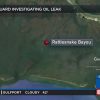
New research has uncovered an added dimension to the decision to inject large amounts of chemical dispersants above the crippled seafloor oil well during the Deepwater Horizon disaster in 2010.
The dispersants, scientists have found, may have significantly reduced the amount of harmful gases in the air at the sea surface -- diminishing health risks for emergency responders and enabling them to keep working to stop the spill and clean it up sooner.
The results were published today in the journal Proceedings of the National Academy of Sciences.
The research team included Jonas Gros, Scott Socolofsky, Anusha Dissanayake and Inok Jun of Texas A&M University; Lin Zhao and Michel Boufadel of the New Jersey Institute of Technology; Christopher Reddy of the Woods Hole Oceanographic Institution; and J. Samuel Arey of the Swiss Federal Institute of Aquatic Science and Technology.
The study was funded by the Gulf of Mexico Research Initiative and the National Science Foundation (NSF).
"In 2010, when NSF began rapid response funding for research on Deepwater Horizon, it was important to characterize the initial conditions of the spill such as plume dynamics and ecological effects," says Don Rice, a program director in NSF's Division of Ocean Sciences, which supported the new research. "These scientists and others did just that. As the findings of this study clearly demonstrate, the discoveries of basic scientific research and the practical applications that follow in their wake are often unanticipated."



